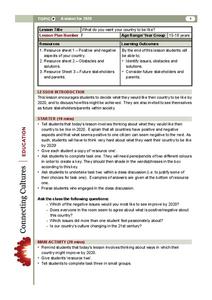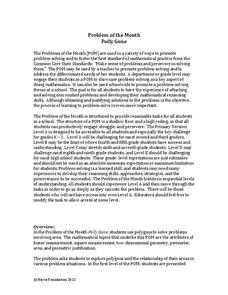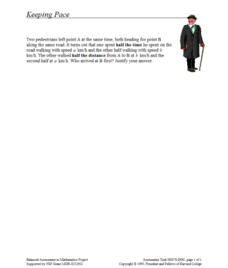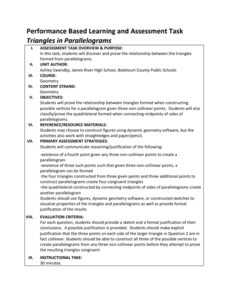Curated OER
The Power of Graphical Display: How to Use Graphs to Justify a Position, Prove a Point, or Mislead the Viewer
Analyze different types of graphs with learners. They conduct a survey and determine the mean, median and mode. They then identify different techniques for collecting data.
CK-12 Foundation
Properties of Equality and Congruence: Justifying Algebraic Steps
No need to justify using this resource. Learners drag justifications for each step of solving an equation in an interactive. To see if they are correct, all they need to do is use a slider and the correct answers appear.
Curated OER
Justifying Answers
Young scholars study story problems and learn how to find and justify their answers. They will use a story problem and then respond to the prompt questions from the teacher. They must add and subtract facts to 6 and learn how to justify...
Alabama Wildlife Federation
Leaf Chromatography
Pigmentation of leaves is important in plant processes. Scholars use chromatography to create a better picture of the pigmentation in an assortment of leaves. They share their results to make comparisons between different plant species.
Visa
Make It Happen: Saving for a Rainy Day
Every little penny counts, especially when it comes to saving for emergencies or long-term goals. Pupils evaluate different saving and investment strategies, such as a CD or money market account, through worksheets and by researching...
MARS - Mathematics Assessment Resource Service
Applying Properties of Exponents
The properties of exponents are all linked together and it is your mathematicians' job to discover and apply those rules. The comprehensive activity begins with a pre-assessment task to check for prior knowledge and then goes into a...
Curated OER
Variation
Learners recognize similarities and differences in plants. In this plants and animals instructional activity, students begin to classify living things by observable characteristics. Learners watch clips from the Internet and play online...
Workforce Solutions
On the Job
Four lessons spotlight a variety of professions while boosting listening and observational skills and making inferences. Lesson one challenges pupils to group cards based on a commonality then justify the relationship they see. Lesson...
Curated OER
The Emancipation Proclamation Through Different Eyes
Students examine how various segments of the American population viewed the Emancipation Proclamation. They read the Emancipation Proclamation, analyze key terms and statements in the document, and participate in a debate.
Ahisma Summer Institute
The Power of One - Math in a Different Angle
In this 2-day lesson focused on exponents, middle schoolers will cross the curriculum by engaging in science, history and language arts activities. Exponential growth will be explored using grains of rice on a chess board. Exponential...
Inside Mathematics
Quadratic (2006)
Most problems can be solved using more than one method. A worksheet includes just nine questions but many more ways to solve each. Scholars must graph, solve, and justify quadratic problems.
University of the Desert
What Do You Want Your Country to be Like?
How would you like your country to be by 2020? What issues do you feel are most important, and how do those compare with your peers? Learners tackle questions regarding the evolving national and global culture of the twenty-first century...
Noyce Foundation
Poly-Gone
Investigate polygons from rectangles to triangles to octagons. Each level of the five-problem series targets a different grade level. Beginning with the level A problem, learners examine the relationship between area and perimeter by...
Concord Consortium
Keeping Pace
What came first, pedestrian one or pedestrian two? Scholars consider a problem scenario in which two people walk at different rates at different times. They must decide who reaches a checkpoint first. Their answers are likely to surprise...
EngageNY
The Volume of Prisms and Cylinders and Cavalieri’s Principle
Young mathematicians examine area of different figures with the same cross-sectional lengths and work up to volumes of 3D figures with the same cross-sectional areas. The instruction and the exercises stress that the two figures do not...
Noyce Foundation
Digging Dinosaurs
Build a function to solve problems rooted in archeology. A comprehensive set of five lessons presents problems requiring individuals to use functions. The initial lesson asks learners to find the possible number of dinosaurs from a...
Kenan Fellows
Isotopic Pennies
Many people confuse atomic mass and atomic numbers. The sixth of seven lessons in a unit requires scholars to find the weight of different groups of pennies. Then, they must solve how many of each type of penny exists in a closed system...
Curated OER
Comparing Fractions
Learners compare three sets of fractions using the greater than, less than, and equal signs. To justify their answers, a drawing is also required that illustrates their reasoning. Including fractions with like and unlike denominators, as...
Bowland
Cats and Kittens
Can a cat have 2,000 descendants in 18 months? To determine if this claim is realistic, individuals must take different pieces of information into account when justifying their responses.
Shodor Education Foundation
Equation Solver
Solve your equation and prove it, too. Young mathematicians solve linear equations using an interactive. They must input a property to justify each step of their solutions.
Radford University
Triangles in Parallelograms
What's the point of looking at triangles when trying to draw parallelograms? Given three non-collinear points, pupils determine and justify all possible points that would create a parallelogram. They then analyze the four triangles that...
K20 LEARN
You Think You Have Problems: Perspective in Multi-Genre Literature
Young scholars are asked to reflect on how personal experiences might influence points of view and perspectives. They read poems and biographies of the poets and then match the poem to the poet. To justify their matches, learners...
Curated OER
Justifying Answers
Students demonstrate how to solve word problems. In this problem solving lesson plan, students use strategies such as drawing pictures, using counters, and making a table to justify how they solved the word problem.
Curated OER
When is Humanitarian Intervention Justified?
Students analyze different foreign policies to derive their own idea of what constitutes appropriate intervention by a government. They complete a detailed proposal for their own Declaration of Human Rights.

























